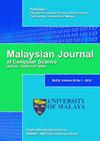AN EXTENSION OF THE OUTLIER MAP FOR VISUALIZING THE CLASSIFICATION RESULTS OF THE MULTI-CLASS SUPPORT VECTOR MACHINE
IF 1.2
4区 计算机科学
Q4 COMPUTER SCIENCE, ARTIFICIAL INTELLIGENCE
引用次数: 0
Abstract
The main objective of this study is a graphical display of the results of the high (as well as the low) dimensional multi-class support vector machine classification. Additionally, we will visually be able to detect the outliers and misclassified observations by using this graphical tool. The “outlier map” as a successful graphical outlier detection tool of robust statistics is extended in this paper. In fact, this is a bilateral extension concerning the misclassified and outlying observations recognition. The most important feature of this extension is creating two types of discriminative boundaries to segregate the data and detect the outlying observations. For this purpose, we employed the simple but efficient concept of the “confidence interval”, which is computed for the mean of decision function of support vector machine and then, “thresholding” technique. After that, the efficiency of the outlier map in terms of the preciseness of the correct outlier identification has been tested by the classification accuracy. Moreover, we deployed the margin width “before” and “after” outlier detection as the other criterion to assess the preciseness of the correct outlier identification. We conducted an empirical study based on the proposed method on the simulated and several well-known real datasets. It shows the effectiveness of our proposed method by increasing the “margin width” and gaining a higher classification accuracy.一种用于可视化多类支持向量机分类结果的离群图扩展
本研究的主要目的是图形显示高(以及低)维多类支持向量机分类的结果。此外,通过使用此图形工具,我们将能够在视觉上检测异常值和错误分类的观测值。本文扩展了“异常值映射”作为一种成功的稳健统计图形异常值检测工具。事实上,这是对错误分类和偏离观测值的承认的双边延伸。这种扩展最重要的特征是创建两种类型的判别边界,以分离数据和检测外围观测。为此,我们采用了“置信区间”的简单而有效的概念,该概念是针对支持向量机的决策函数的均值计算的,然后是“阈值”技术。之后,通过分类精度测试了异常值图在正确异常值识别精度方面的效率。此外,我们将异常值检测“之前”和“之后”的裕度作为评估正确异常值识别准确性的另一个标准。我们在模拟数据集和几个著名的真实数据集上基于所提出的方法进行了实证研究。通过增加“边缘宽度”和获得更高的分类精度,表明了我们提出的方法的有效性。
本文章由计算机程序翻译,如有差异,请以英文原文为准。
求助全文
约1分钟内获得全文
求助全文
来源期刊

Malaysian Journal of Computer Science
COMPUTER SCIENCE, ARTIFICIAL INTELLIGENCE-COMPUTER SCIENCE, THEORY & METHODS
CiteScore
2.20
自引率
33.30%
发文量
35
审稿时长
7.5 months
期刊介绍:
The Malaysian Journal of Computer Science (ISSN 0127-9084) is published four times a year in January, April, July and October by the Faculty of Computer Science and Information Technology, University of Malaya, since 1985. Over the years, the journal has gained popularity and the number of paper submissions has increased steadily. The rigorous reviews from the referees have helped in ensuring that the high standard of the journal is maintained. The objectives are to promote exchange of information and knowledge in research work, new inventions/developments of Computer Science and on the use of Information Technology towards the structuring of an information-rich society and to assist the academic staff from local and foreign universities, business and industrial sectors, government departments and academic institutions on publishing research results and studies in Computer Science and Information Technology through a scholarly publication. The journal is being indexed and abstracted by Clarivate Analytics'' Web of Science and Elsevier''s Scopus
 求助内容:
求助内容: 应助结果提醒方式:
应助结果提醒方式:


